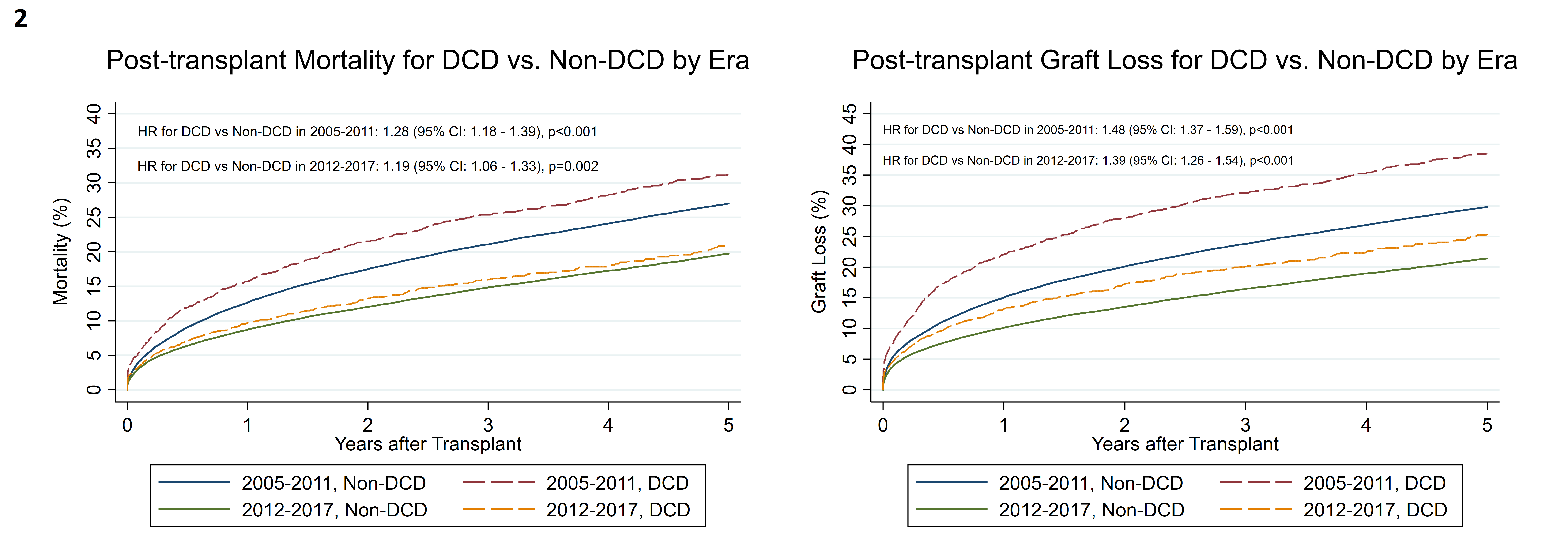Temporal Trends in Utilization and Outcomes of DCD Livers for Liver Transplantation in the United States
Johns Hopkins University, Baltimore, MD
Meeting: 2020 American Transplant Congress
Abstract number: A-121
Keywords: Allocation, Donors, marginal, Outcome
Session Information
Session Name: Poster Session A: Liver: MELD, Allocation and Donor Issues (DCD/ECD)
Session Type: Poster Session
Date: Saturday, May 30, 2020
Session Time: 3:15pm-4:00pm
 Presentation Time: 3:30pm-4:00pm
Presentation Time: 3:30pm-4:00pm
Location: Virtual
*Purpose: Donation after cardiac death (DCD) livers represent a possible expansion to the donor pool, but are frequently discarded due to an increased mortality and graft loss. However, changes in recipient/donor characteristics, allocation policy, and clinical protocols over the last decade might have altered the utilization and outcomes of DCD livers.
*Methods: We used national SRTR registry data from 2005-2017 and adjusted multi-level logistic regression to quantify temporal trends in discard rates of DCD livers. We then used adjusted Cox regression to characterize temporal trends in post-transplant mortality and graft loss for DCD liver recipients.
*Results: We identified 5,977 DCD livers recovered for transplantation; 29.7% of DCD livers were discarded in 2005, whereas 28.9% were discarded in 2017 (p=0.1) (Figure 1A). After adjusting for donor characteristics and accounting for OPO-level variation, DCD livers were always more likely to be discarded compared to non-DCDs, and actually became even more likely to be discarded over time (adjusted odds ratio [aOR] of being discarded DCD versus non-DCD, in 2005-2007: 3.854.455.14; 2008-2011: 5.115.776.50; 2012-2014: 4.625.306.08; 2015-2017: 5.225.876.59). Between-OPO differences in DCD liver discard accounted for only 5.6% of the total variation in DCD discard (Figure 1B). In contrast to the increasing likelihood of DCD discard over time, post-transplant outcomes of DCD liver recipients improved over time. Compared to DCD liver recipients from 2005-2011, DCD liver recipients from 2012-2017 had a 44% lower mortality risk (adjusted hazard ratio [aHR]: 0.490.560.65, p<0.001) and a 43% lower risk of graft loss (aHR: 0.490.570.65, p<0.001). This translated to a 19% higher mortality risk in the recent era for DCD vs. non-DCD recipients (vs. 28% in the earlier era), and a 39% higher risk of graft loss (vs. 48%) (Figure 2).
*Conclusions: Although outcomes of DCD liver recipients have improved over time, DCD livers remain substantially more likely to be discarded than non-DCD livers, and this discrepancy has actually increased over time. Increasing utilization of DCD livers might be a reasonable strategy to expand the donor pool.
To cite this abstract in AMA style:
Jackson KR, Motter J, Massie A, Philosophe B, Garonzik-Wang J, Segev D. Temporal Trends in Utilization and Outcomes of DCD Livers for Liver Transplantation in the United States [abstract]. Am J Transplant. 2020; 20 (suppl 3). https://atcmeetingabstracts.com/abstract/temporal-trends-in-utilization-and-outcomes-of-dcd-livers-for-liver-transplantation-in-the-united-states/. Accessed December 15, 2025.« Back to 2020 American Transplant Congress


